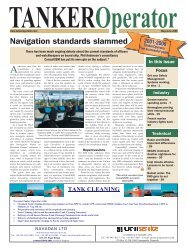Features: - Tanker Operator
Features: - Tanker Operator
Features: - Tanker Operator
You also want an ePaper? Increase the reach of your titles
YUMPU automatically turns print PDFs into web optimized ePapers that Google loves.
not specific and does not tell the analyst what<br />
the hydrocarbon is. In terms of monitoring<br />
tank cleaning, it is very important to know the<br />
nature of the hydrocarbon, because this can<br />
directly impact on the subsequent cleaning<br />
steps. It could be:<br />
i) Previous cargo.<br />
ii) Tank cleaning chemicals.<br />
iii) Old cargo absorbed into coated surfaces.<br />
iv) Reaction of the wall wash solvent with the<br />
coating.<br />
v) Other - for example hydraulic oil, leaking<br />
adjacent cargo etc.<br />
Different hydrocarbon products also have<br />
different responses to the hydrocarbon test,<br />
depending on the relative solubility of the<br />
hydrocarbon in water. The most common<br />
Five of eight 5,600 dwt double<br />
hull chemical tankers delivered to<br />
Bergen-based Mowinckel are<br />
fitted with a Norclean super<br />
stripping system. The other three<br />
are still under construction.<br />
According to Mowinckel Ship Management's<br />
Ove Berntzen, the advantage in fitting the<br />
systems is the reduced time and work needed<br />
for tank cleaning. "In many cases there is no<br />
need to gas free the vessel and go down to<br />
collect the remaining liquid", Berntzen said.<br />
"When we are using the super stripping<br />
system, the remaining liquid is only 0.5-1 litre<br />
in each bilge well. If, for instance, the<br />
remaining cargo is gasoline, we just run the<br />
nitrogen system to clear out the remaining<br />
liquid," he explained.<br />
For these types of vessels, the requirements<br />
for stripping is a maximum of 75 litres<br />
hydrocarbon products to slip under the net of<br />
the hydrocarbon test are aromatics, because<br />
many aromatics have a very slight solubility<br />
in water.<br />
For example toluene has a solubility in<br />
water of approximately 0.18%, meaning that if<br />
the wall wash sample contained for example<br />
0.175% toluene, it would pass the<br />
hydrocarbon test. Clearly having 1,750 ppm of<br />
toluene in a wall wash sample is not the<br />
preferred objective, yet this is quite possible.<br />
Accurately monitoring tank cleaning goes<br />
beyond just 'passing' a wall wash sample and<br />
if done correctly, the cargo tanks will actually<br />
be much cleaner than passing an independent<br />
wall wash inspection.<br />
The responsibility for the tank cleaning is<br />
remaining in each tank with the associated<br />
piping system.<br />
He said that during stripping tests on board<br />
one of the sisterships, the remaining cargo was<br />
found to be 24-50 litres. "As we comply with<br />
the stripping requirements by the use of<br />
'normal' stripping, we do not use the super<br />
stripping system during normal unloading<br />
operations", he explained.<br />
Each ice class tanker has a cargo carrying<br />
capacity at 98% of 6,350 cu m and 138 cu m<br />
of slops and has 13 cargo segregations each<br />
with a double valve. They are fitted with<br />
eight 200 cu m per hour, four 150 cu m<br />
per hour and one 100 cu m per hour<br />
centrifugal pumps.<br />
They are provided with a cargo stock on<br />
each side and a common line of 200 mm port<br />
and starboard for and aft of the manifold.<br />
All the tanks can be discharged through any<br />
TECHNOLOGY - TANK CLEANING<br />
always on the vessel and in the case of a cargo<br />
tank rejection or cargo contamination claim<br />
there is no recourse on the choice of tank<br />
cleaning guide or the validity of the<br />
independent load port inspection. The vessel<br />
has to know how clean the cargo tanks are<br />
before any cargo is loaded and without<br />
monitoring the tank cleaning process this<br />
TO<br />
is impossible.<br />
*This article was written by Guy<br />
Johnson, BSc (Hons) MRSC CChem<br />
CSci), director L&I Maritime (UK)<br />
operations@limaritime.com<br />
Tel. +44 1909 532 003<br />
Super stripping system fitted on board small chemical tankers<br />
of the common lines and/or separately through<br />
the manifold. A stern line of 200 mm is also<br />
fitted. Each presentation flange from the COT<br />
is of DIN standard and 150 mm.<br />
The entire cargo system is constructed of<br />
stainless steel and the vessels are coated with<br />
MarineLine. As well being fitted with the<br />
Norclean super stripping system, a nitrogen<br />
system was also installed in the tanks for<br />
inerting and purging.<br />
Out of the eight DNV classed vessels, the<br />
Frosta, Troma, Lycian, Lydian and Ionian<br />
have been delivered, while the remaining<br />
three - Hadra, Hitra and Vinga will follow<br />
this year and next. They are all products of<br />
the Celik Tekne Shipyard in Tuzla, near<br />
Istanbul.<br />
Of the vessels in service, Frosta is chartered<br />
to Esso Norge, Troma, Lycian and Lydian to<br />
StatoilHydro and the Ionian to Gefo. TO<br />
Left: The stripping requirement is a maximum of 75 litres for this type of vessel. Right: Troma is long term chartered to StatoilHydro.<br />
August/September 2008 � TANKER<strong>Operator</strong> 59

















